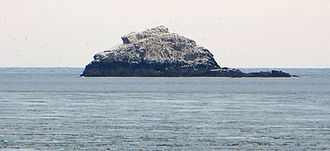Ortac
Victor Hugo, who lived on Guernsey, and who wrote much about the Channel Islands says in his novel, The Laughing Man (L'Homme qui Rit): ...on the port bow arose, standing stark, cut out on the background of mist, a tall opaque mass, vertical, right-angled, a tower of the abyss.
The Ortac, all of a piece, rises up in a straight line to eighty feet above the angry beating of the waves... An immovable cliff, it plunges its rectilinear planes apeak into the numberless serpentine coils of the sea.
In time of storm it awaits the stroke of the axe which is 'the thunderclap'...To be wrecked on the Casquets is to be cut into ribbons; to strike on the Ortac is to be crushed into powder... On a straight frontage, such of that of the Ortac, neither the wave nor the cannon ball can ricochet... if the wave carries the vessel on the rock she breaks on it, and is lost...Meanwhile, in another work, The Toilers of the Sea (Les Travailleurs de la mer), he mentions the curious anecdote that Ortac was inhabited by Saint Malo: The Norman fishermen who frequent the Channel have many precautions to take at sea, by reason of the illusions with which Satan environs them.
It has long been an article of popular faith that Saint Maclou inhabited the great square rock called Ortac, in the sea between Alderney and the Casquets; and many old sailors used to declare that they had often seen him there, seated and reading a book.
Accordingly the sailors, as they passed, were in the habit of kneeling many times before the Ortac rock, until the day when the fable was destroyed, and the truth took its place.
This sort of weeding of the saintly calendar is certainly very useful; but it can only be practiced by very accomplished judges of devils and their ways.The islet is noted for its large gannet colony.


